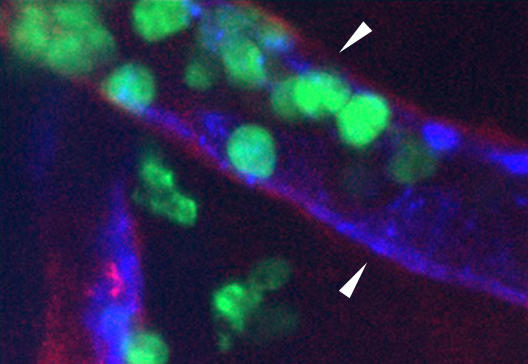Tracking inflammatory processes

Which molecular mechanisms are at work when, in the case of inflammation, immune cells migrate from the blood vessel into the tissue? Researchers at the Cells-in-Motion Cluster of Excellence at Münster University have gained new insights into this question: the laminin 511 protein, that underlies endothelial cells that form the inner cell layer of the blood vessel wall, influences how permeable the vessel is for immune cells. The study has been published in the journal “Cell Reports”.
Immune cells – leukocytes – are a kind of health police in the body. They circulate in the bloodstream and patrol the vessels of all the organs. When inflammation occurs, immune cells migrate from the blood into the tissue, where they fight the inflammation. To get into the tissue, they have to overcome two barriers. One is a thin layer of endothelial cells that coat the blood vessels and a second protein barrier – the basement membrane – that underlies the endothelial layer and forms the outer portion of the vessel wall.
In previous studies, researchers at the Cells-in-Motion Cluster of Excellence had discovered that specific proteins in the basement membrane – so-called laminins – influence the migration of the immune cells. For example, they determine the place at which immune cells cross the basement membrane and enter into the tissue. Researchers have now discovered that these components of the basement membrane also affect the inner endothelial cell layer. “A certain laminin – laminin 511 – influences how tightly endothelial cells are connected to each other,” explains biochemist Prof. Lydia Sorokin. This is because laminin affects specific molecules that interconnect endothelial cells. For one thing, laminin stabilizes the VE-cadherin molecule at contact sites between adjacent endothelial cells, forming a sort of Velcro fastener between them. In addition, laminin 511 reduces the quantity of a molecule known as “CD99L2”. This is found on both the endothelial cells and on the immune cells and permits the two types of cell to interact. If the amount of CD99L2 on the endothelium is reduced, this reduces interactions with the same molecule on immune cells, thus slowing the transmigration of immune cells across the endothelial cell layer.
In addition, for the first time this study determined how long immune cells need to penetrate the basement membrane after crossing the endothelial cell layer. The researchers measured a time of 40 minutes; in comparison, the immune cells needed only a few minutes to pass through the endothelial cell layer. This indicates that migration across the basement membrane is a critical event in inflammation.
Previously, the researchers had focused on blood vessels of the brain. In this latest study they looked at blood vessels in the cremaster muscle of mice – a particularly thin muscle that permits live imaging of immune cells within blood vessels and migrating into the muscle tissue, after application of an inflammatory stimulus. They found that there are differences in the interrelationship between laminin 511 und VE-cadherin in different tissues. “This shows that not every inflammatory process is the same, but can vary between organs,” says Lydia Sorokin.
Various groups of researchers at the Cluster of Excellence worked together on the interdisciplinary study. The study involves basic research and while applicable to the treatment of inflammation, this potential cannot be predicted at present. A fundamental knowledge of the function of blood vessels and of inflammatory processes is, however, a prerequisite for developing therapies for tissue-specific inflammations.
The study was supported by Münster University’s Cells-in-Motion Cluster of Excellence and the Collaborative Research Centre 1009 – “Breaking Barriers” – funded by the German Research Foundation.
On collaboration between researchers from various disciplines and the methods used:
The research group headed by biochemist Prof. Lydia Sorokin, specialises in the study of laminins and basement membranes; they worked together with Prof. Dietmar Vestweber, also a biochemist and specialist on the VE-cadherin molecule, and Prof. Alexander Zarbock, an anaesthetist, who contributed a special method, intravital microscopy. “This enabled us to visualize the blood vessels and migrating immune cells in this very thin muscle in real time, and to develop ways of looking at the basement membrane –which is difficult to visualize,” Lydia Sorokin explains. “For this purpose we used special antibodies from our laboratory that recognize the laminins 511.” In mice, whose immune cells had been genetically marked with green fluorescent protein (GFP), the researchers looked to see at which places greater number of immune cells penetrated the barriers. The basement membrane was marked with a red fluorescent labelled antibody, the endothelial cell layer with a different blue fluorescent signal. If the fluorescent substance is exposed for too long, however, it fades. So the task of mathematician Prof. Benedikt Wirth was to reconstruct where the original fluorescent signals were located, which permitted precise localization of where immune cells penetrated the endothelial and the basement membrane barriers, and accurate calculation of how long each step took. Prof. Heinz Wiendl, a neurologist, contributed a method of measuring the resistance of the endothelial cell layer before and during immune cells migration across the barrier in the presence or absence of the laminin 511 barrier.
Original publication:
Song J, Zhang X, Büscher K, Wang Y, Wang H, Di Russo J, Li L, Ludke-Enking S, Zarbock A, Stadtmann A, Striewski P, Wirth B, Kuzmanov I, Wiendl H, Schulte D, Vestweber D, Sorokin L. Endothelial basement membrane laminin 511 contributes to endothelial junctional tightness and thereby inhibits leukocyte transmigration. Cell Rep 2017, DOI: 10.1016/j.celrep.2016.12.092 Abstract

